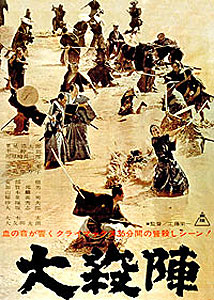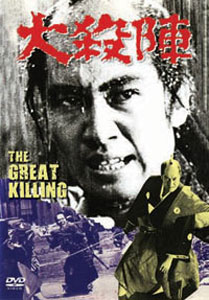 Set in 1678, the time of the 4th Shogun, Dai satsujin (The Great Killing; or, The Great Duel, 1964) was inspired in part by the assassination in 1960 of Asanuma Inejiro, leader of the Japanese Socialist Party, when seventeen year old right-wing student Otoya Yamaguchi stabbed the politician during a televised rally. Set in 1678, the time of the 4th Shogun, Dai satsujin (The Great Killing; or, The Great Duel, 1964) was inspired in part by the assassination in 1960 of Asanuma Inejiro, leader of the Japanese Socialist Party, when seventeen year old right-wing student Otoya Yamaguchi stabbed the politician during a televised rally.
The assassination news footage is as famous in Japan as the televised 1968 Sirhan Sirhan assassination of Bobby Kennedy is in America, & can be viewed at youtube, here: Asanuma Inejiro Assassination Footage (1960).
Any comparison between that shocking bit of history & the events of Dai Satsujin is tangential at best, the main contribution being how the assassination & riots between students & police lent modern relevance to the story of 17th Century rebels plotting against Lord Yutanokami Sakai (Ryutaro Otomo) of the Tokugawa bakufu.
Otomo was noted for playing casual fun-loving rugged rogues, the chivalrous ronin-with-a-smile. Even when he played a character like the Shogun (as in the Shingo Aoi series), he retained a jolly goodnatured attribute. But as Lord Sakai he is terribly severe & serious, bordering on frightening, & shows fine acting ability well beyond his usual reliance on Gene Autryesque screen charisma. He often worked with Eiichi Kudo who could get great performances out of him, even in those far less serious films that were the majority.
The fourth Shogun has proven a weak ruler in a time of farmer riots & rural samurai uprisings. Lord Sakai hopes to have the final say-so on who becomes the fifth shogun, as Shogun Ietsuna has no heir.
Yutanokami Sakai is based on Tadakiyo Sakai, a historical figure who really did attempt to establish a puppet-shogun & failed, but since the actual fifth Shogun Tsunayoshi was a simpleminded nutter who preferred dogs to people, it's a major historical question whether or not Sakai's attempt to establish someone else was or wasn't self-serving.
Dai satsujin is regarded as the second of Eiichi Kudo's "Samurai Revolution Trilogy," following Thirteen Assassins (Juusan-nin no shikaku, 1963), & preceding Eleven Samurai (Ju-ichinin no samurai, 1966). These films do not upraise Kudo to the level of Kobayashi or Kurosawa, but indicate that had Japan's studio system permitted him more freedom to develop projects, rather than assigning commercial projects, he might well have gained a greater international reputation as a Golden Age director.
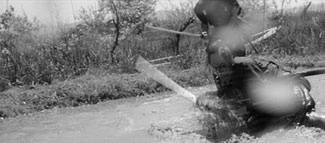 Dai satsujin is a doomful film, widescreen black & white cinematography, very noirish, of a sub-genre of historical action films called zongoku jidai-geki or cruel historical tales. Dai satsujin is a doomful film, widescreen black & white cinematography, very noirish, of a sub-genre of historical action films called zongoku jidai-geki or cruel historical tales.
As the story opens, shogunate officials have a list of rebels, mostly ronin, who are planning the overthrow of Lord Sakai, who they regard as power-hungry & corrupt.
Really Sakai seems a fairly regular politician & any attempt to completely fathom the rebels' motivations will be frustrating, as it would be with most radicals who have their own way of thinking. Lord Sakai is pursuing political machinations to upraise his own choice for the 5th Shogun, but that sort of thing is par for the course.
Sakai would influence the choice to be Tsunahoshi the son of Chancellor Kofu, which would shift the shogunate out of the hands of the Tokugawa clan. As Chancellor Kofu is rather effete, & his son still a child, Sakai will be able to rule behind the scenes as a shadow-regent.
Why the rebels find this corrupt rather than typical of bakufu politicking, & so would preserve the Tokugawa lineage which has been the real source of their suffering, is never nearly as sensible as they themselves believe.
It is nevertheless their unwavering motivation, much as that modern-day teenage assassin believed wholeheartedly the nonsense of far-right student revolutionists of the 1960s who would promulgate the restoration of Emperor worship & feudalism as a dream come true.
Believing that Sakai's increasing power would lead to "generations" of suffering for ronin & peasant alike, an expansive conspiracy is underway, with Lord Sakai the intended target. But secrets inevitably leak, & shogunate vassals are soon scouring the castle-town, arresting & killing the majority of the conspirators.
No one will reveal the leader's name, however, who with a handful of survivors will drum up a secondary plot for which they will give their lives. Their tiny band intends to attack Chancellor Kofu while he is on a journey, as without him, Lord Sakai's machinations will crumble, & a branch of the Tokugawa family will be forced to intervene in the matter of heir selection.
This political content of the film is by no means the best thing about it. Some of it is dull, & for viewers not at all versed in Japanese history, it is apt to be impenetrable. A lot of screen time is devoted to the politics of the situation, while awaiting the next scenes of cruelty or carnage. Yet the attentive viewer will find reward even in these static scenes of political intrigue & discussion.
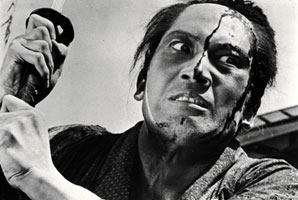 Early in the film, one of the rebels, Nakajima Geki, is fleeing the round-up. He attempts to find refuge in young Sir Jinbo's residence. Jinbo is played by youth-star Kotaro Satomi, who had his first shots at serious roles thanks to Eichii Kudo. Early in the film, one of the rebels, Nakajima Geki, is fleeing the round-up. He attempts to find refuge in young Sir Jinbo's residence. Jinbo is played by youth-star Kotaro Satomi, who had his first shots at serious roles thanks to Eichii Kudo.
Jinbo is in his bath, having a lovely interaction with his beautiful wife Kayo. He's clearly a privileged vassal with significant stipend, as he seems wealthy. He has no connection whatsoever to rebels, but knows Nakajima.
He has no idea why his friend is in a panic, let alone why shogunate samurai are at that moment breaking into his home in a threatening manner. All he wants is for everyone to calm down & explain this intrustion to him. But it looks like he's protecting the rebel.
So men obedient to official orders very brutally, horrifically cut down Nakajima, arrest the confused Jinbo, & since his wife won't stop yelling hysterically for her husband, she's cut down in the street for no reason at all, then left their to rot as a warning to others.
This certainly sets the mood for the nature of the violence that will erupt occasionally during the tale, & dominate the appalling climax. No one takes pretty postures & makes artful easy cuts. It is an era of peace; samurai no longer really know how to fight. They can kill easily enough, but they might as well be armed with meat cleavers & mallots.
Escaping the men who arrested him without cause, Jinbo flees through muddy streets still wearing the yakata (bathrobe) he put on from his bath, barefoot & without his swords.
He is aided by a selfless otherwise uninvolved Matonoshi Asari (Mikijiro Hira), a nonviolent ronin who just likes a good time. He has sold off every possession to get by, save only for his katana & wakizashi (long & short sword set), family heirlooms he cannot bare to part with despite having no desire ever to use them.
Matonoshi protects Jinbo for a while, but they have a parting of the ways when he discovers Jinbo has joined the last few rebels & has that very day killed a man who wanted out of the conspiracy.
They strongly disagree of proper actions in this difficult world. Matonoshi has "dropped out" refusing to be part of the system, preferring to respect all life & enjoy what pleasures come his way. Jinbo is convinced a reasonable man, having his eyes opened to injustice, has a responsibility to instigate disrupting action to unsettle the status quo. Before they part, Jinbo says, "You don't deserve these!" & takes Matonoshi's swords.
The source of Jinbo's new radicalism is a woman rebel, Miya, who convinced him there was a better way to avenge his wife, now that he knows of what this government is capable. She takes him to meet Hoshino Tomonojo, a gentle ronin & family man, making ends meet by constructing umbrellas. Tomonojo manages to be a very upbeat guy, as he has a beautiful family as consolation. He hides Jinho when Miya requests he do so.
Eventually shogunate investigators uncover the identity of the brain behind the attempted rebellion. It's Yamaga Soko, head of an important school of swordsmanship. This character's based on an historical Neo-Confucian philosopher & strategist, author of central works on bushido or the Way of the Warrior.
The film in no way adheres to Yamaga Soko's authentic biography, but as history's Yamaga did believe the samurai class was at risk of decline in a time of peace, it is certainly not too absurd a stretch to suppose he might instigate dangerous action among his disciples.
Yamaga is Miya's uncle & together they are the center of the failed rebellion, & remain central to the new, scaled down assassination plot. The authorities are after the remaining band, so they go into hiding. Jinbo is as ready as any to die for this cause, though only seven days before he had been a privileged vassal with no worries in the world.
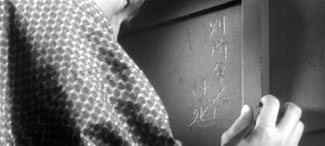 Hoshino, the happy family man, returns home on the day of the planned assault on Chancellor Kofu. Hoshino, the happy family man, returns home on the day of the planned assault on Chancellor Kofu.
[SPOILER ALERT!; do not read the rest of the review if you're about to see the movie.] Hoshino enjoys his family one last time, then provides one of the film's cruelest of this film's many cruel moments before he sets out to join his fellow conspirators.
Around the same time, the monk Kusaka, a crazed fanatic, attempts to rape Miya for the second time, to enjoy her flesh before he dies. As she fights him bitterly, he kills her, then hurries to join the others who will never know what he did.
They have arranged to induce Chancellor Kofu's retinue to change their itinerary so that it passes through a corner of the Yoshiwara pleasure district. They will launch their ambush on a busy street.
It's the annual cleaning day, so that tatami mats & futon beds are being brought outside for airing & dusting. Civillians including children are obviously in the way of the pending danger.
As Chancellor Kofu's military escort draws near, our band of assassins lurk in sundry places on the street of Yoshiwara, trying not to be conspicuous. The youngest scratches a sort of farewell to the world on a wall, then is embarrassed & scratches it out. A chubby cospirator sweats & looks terrified; he will ultimately take to cowardly flight at a moment when he is most needed.
Meanwhile Lord Sakai & his chief inspector have detected the plot & are rushing to save unsuspecting Chancellor Kofu. But Kofu is already under attack. His samurai guard were hardly more than courtiers, but so outnumber the little band of assassins it seems unlikely they can lose, especially as the rebels are hardly less awkward in their attack.
Chancellor Kofu is surrounded by frightened defenders as they flee down a river canal, the clumsy battle first in then out of the water. Everyone looks hellish & afraid, & none can catch their breath. Sharp angles & hand-held camera movement increases the sense of no one being in control of anything that happens. Everyone fights like terrified blind men. Innocent bystanders fall screaming as readily as anyone.
It's a very protracted, horrific, ugly battle, but one by one, our small band of assassins fall, their aim unachieved. When Lord Sakai arrives with his men, the bloody ambush is over, & he's relieved to see Chancellor Kofu is safe.
Matonoshi, the pacifistic devil-may-care ronin who had once helped Jinbo, sees his friend dead, with Matonoshi's own heirloom sword still clutched, broken, in his fist. Passing by in all safety, lords Kofu & Sakai are laughing as though nothing dreadful has happened. Matonoshi pries his broken sword from Jinbo's stiff dead hand, & runs after Chancellor Kofu, cutting him down, then being himself cut down soon after.
"I'm screwed," says Lord Sakai. "This is the end." As it sinks in what the outcome will be for himself, he lifts Chancellor Kofu's body up & places it in the palanquin, & begins to insist Lord Kofu is alive & safe. It's a kabukiesque outpouring of crazed denial, a fairly jaw-dropping capper to a long bloody climax.
copyright © by Paghat the Ratgirl
|
